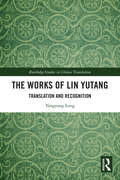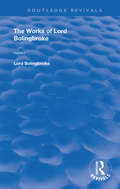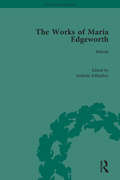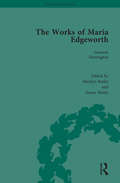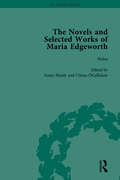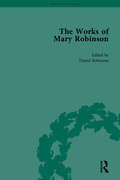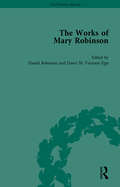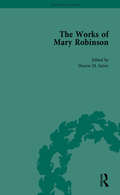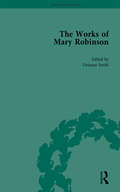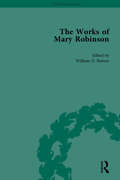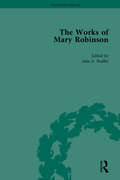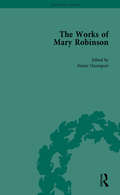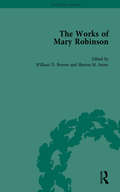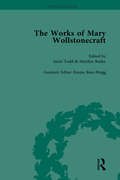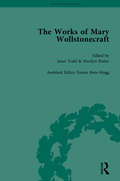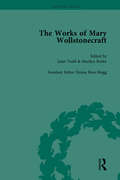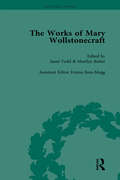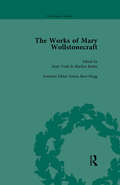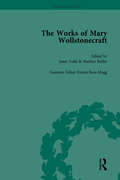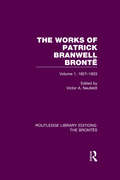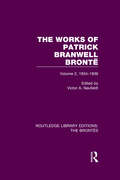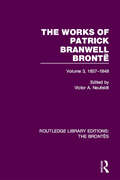- Table View
- List View
The Works of Lin Yutang: Translation and Recognition (Routledge Studies in Chinese Translation)
by Yangyang LongThe Works of Lin Yutang is the first book to provide a comprehensive study of Lin Yutang’s translation theory and translated (and written) works in English as a whole, examined from the perspective of his pursuit of recognition of cultural equity between China and the English-speaking world. The arc of the book is Lin’s new method of translating China to the Anglophone world, which is crucial to rendering Chinese culture as an equal member of the modern world. This book identifies Lin’s legacy of translation and recognition as his acknowledgement of source and target cultural territories in translation, and at the same time, his questioning of perspectives that privilege the authority of either. This book will appeal to scholars and students in Translation Studies, World and Comparative Literature, Literary and Cultural Studies, and Chinese Studies. It can also be used as a reference work for practitioners in translation and creative writing.
The Works of Lord Bolingbroke: Volume 1 (Routledge Revivals)
by Henry St. BolingbrokePublished in 1967: Accuracy and impartiality have been studied in the following Biography, more than elegance and that labored eulogy, which so often defeats its purpose. The quick genius and diversified attainments of the author and the statesman, have not been allowed to cast a glare over the vices of the man and the specious hollowness of the pretended philosopher.
The Works of Maria Edgeworth, Part I Vol 2
by Marilyn ButlerThis volume contains Edgeworth's best courtship novel belinda, which replaces mercenary fortune-hunting with a deeper quest for marital compatibility, valorising irrationality and love over reason and duty. MARIA EDGEWORTH was born in 1768. Her first novel, Castle Rackrent (1800) was also her first Irish tale. The next such tale was Ennui (1809), after which came The Absentee, which began life as an unstaged play and was then published (in prose) in Tales of Fashionable Life (1812), as were several of her other stories. They were followed in 1817 by the last of her Irish tales, Ormond. Maria Edgeworth died in 1849. Edited with an introduction and notes by Marilyn Butler.
The Works of Maria Edgeworth, Part I Vol 3
by Marilyn ButlerThis book is a collection of novels Leonora and Harrington by Maria Edgeworth that address issues of nationalism in an Anglo-Irish context and that will be of much use to scholars, students and general readers interested in fictional works. MARIA EDGEWORTH was born in 1768. Her first novel, Castle Rackrent (1800) was also her first Irish tale. The next such tale was Ennui (1809), after which came The Absentee, which began life as an unstaged play and was then published (in prose) in Tales of Fashionable Life (1812), as were several of her other stories. They were followed in 1817 by the last of her Irish tales, Ormond. Maria Edgeworth died in 1849. Edited with an introduction and notes by Marilyn Butler.
The Works of Maria Edgeworth, Part I Vol 4
by Marilyn ButlerThis book presents a selection of the educational and occasional writings of Maria Edgeworth. It shows how Maria Edgeworth familiarised herself with the remarkably acute, closely-observed treatises and essays of the true Renaissance man, Francis Bacon. MARIA EDGEWORTH was born in 1768. Her first novel, Castle Rackrent (1800) was also her first Irish tale. The next such tale was Ennui (1809), after which came The Absentee, which began life as an unstaged play and was then published (in prose) in Tales of Fashionable Life (1812), as were several of her other stories. They were followed in 1817 by the last of her Irish tales, Ormond. Maria Edgeworth died in 1849. Edited with an introduction and notes by Marilyn Butler.
The Works of Maria Edgeworth, Part I Vol 5
by Marilyn ButlerThis book is a collection of novels The Absentee, Madame de Fleury, and Emilie de Coulanges by Maria Edgeworth that address issues of nationalism in an Anglo-Irish context and that will be of much use to scholars, students and general readers interested in fictional works. MARIA EDGEWORTH was born in 1768. Her first novel, Castle Rackrent (1800) was also her first Irish tale. The next such tale was Ennui (1809), after which came The Absentee, which began life as an unstaged play and was then published (in prose) in Tales of Fashionable Life (1812), as were several of her other stories. They were followed in 1817 by the last of her Irish tales, Ormond. Maria Edgeworth died in 1849. Edited with an introduction and notes by Marilyn Butler.
The Works of Maria Edgeworth, Part II Vol 9
by Marilyn ButlerPresents scholars, students and general readers with the major fiction for adults, much of the best of juvenile fiction, and a selection of the educational and occasional writings of Maria Edgeworth. MARIA EDGEWORTH was born in 1768. Her first novel, Castle Rackrent (1800) was also her first Irish tale. The next such tale was Ennui (1809), after which came The Absentee, which began life as an unstaged play and was then published (in prose) in Tales of Fashionable Life (1812), as were several of her other stories. They were followed in 1817 by the last of her Irish tales, Ormond. Maria Edgeworth died in 1849. Edited with an introduction and notes by Marilyn Butler.
The Works of Mary Robinson, Part I Vol 1
by Daniel Robinson Orianne Smith William D Brewer Sharon M SetzerRegularly the subject of cartoonists and satirical novelists, Mary Robinson achieved public notoriety as the mistress of the young Prince of Wales (George IV). Her association with figures such as William Godwin and Mary Wollstonecraft, and comparisons with Charlotte Smith, make her a serious figure for scholarly research.
The Works of Mary Robinson, Part I Vol 2
by Daniel Robinson Orianne Smith William D Brewer Sharon M SetzerRegularly the subject of cartoonists and satirical novelists, Mary Robinson achieved public notoriety as the mistress of the young Prince of Wales (George IV). Her association with figures such as William Godwin and Mary Wollstonecraft, and comparisons with Charlotte Smith, make her a serious figure for scholarly research.
The Works of Mary Robinson, Part I Vol 3
by Daniel Robinson Orianne Smith William D Brewer Sharon M SetzerRegularly the subject of cartoonists and satirical novelists, Mary Robinson achieved public notoriety as the mistress of the young Prince of Wales (George IV). Her association with figures such as William Godwin and Mary Wollstonecraft, and comparisons with Charlotte Smith, make her a serious figure for scholarly research.
The Works of Mary Robinson, Part I Vol 4 (The\pickering Masters Ser.)
by Daniel Robinson Orianne Smith William D Brewer Sharon M SetzerRegularly the subject of cartoonists and satirical novelists, Mary Robinson achieved public notoriety as the mistress of the young Prince of Wales (George IV). Her association with figures such as William Godwin and Mary Wollstonecraft, and comparisons with Charlotte Smith, make her a serious figure for scholarly research.
The Works of Mary Robinson, Part II vol 5
by William D Brewer Hester Davenport Julia A ShafferRegularly the subject of cartoonists and satirical novelists, Mary Robinson achieved public notoriety as the mistress of the young Prince of Wales (George IV). Her association with figures such as William Godwin and Mary Wollstonecraft, and comparisons with Charlotte Smith, make her a serious figure for scholarly research.
The Works of Mary Robinson, Part II vol 6
by William D Brewer Hester Davenport Julia A ShafferRegularly the subject of cartoonists and satirical novelists, Mary Robinson achieved public notoriety as the mistress of the young Prince of Wales (George IV). Her association with figures such as William Godwin and Mary Wollstonecraft, and comparisons with Charlotte Smith, make her a serious figure for scholarly research.
The Works of Mary Robinson, Part II vol 7
by William D Brewer Hester Davenport Julia A ShafferRegularly the subject of cartoonists and satirical novelists, Mary Robinson achieved public notoriety as the mistress of the young Prince of Wales (George IV). Her association with figures such as William Godwin and Mary Wollstonecraft, and comparisons with Charlotte Smith, make her a serious figure for scholarly research.
The Works of Mary Robinson, Part II vol 8 (The\pickering Masters Ser.)
by William D Brewer Hester Davenport Julia A ShafferRegularly the subject of cartoonists and satirical novelists, Mary Robinson achieved public notoriety as the mistress of the young Prince of Wales (George IV). Her association with figures such as William Godwin and Mary Wollstonecraft, and comparisons with Charlotte Smith, make her a serious figure for scholarly research.
The Works of Mary Wollstonecraft Vol 1: Education Of Daughters, Female Reader, Original Stories, Management Of Infants, Lessons (The\pickering Masters Ser.)
by Janet Todd Marilyn ButlerA seven volume set of books containing all the known published writings and translations of Mary Wollstonecraft, who is generally recognised as the mother of the feminist movement. She was also an acute observer of the political upheavals of the French revolution and advocated educational reform.
The Works of Mary Wollstonecraft Vol 2
by Janet Todd Marilyn Butler Emma Rees-MoggA seven volume set of books containing all the known published writings and translations of Mary Wollstonecraft, who is generally recognised as the mother of the feminist movement. She was also an acute observer of the political upheavals of the French revolution and advocated educational reform.
The Works of Mary Wollstonecraft Vol 3
by Janet Todd Marilyn ButlerA seven volume set of books containing all the known published writings and translations of Mary Wollstonecraft, who is generally recognised as the mother of the feminist movement. She was also an acute observer of the political upheavals of the French revolution and advocated educational reform.
The Works of Mary Wollstonecraft Vol 4
by Janet Todd Marilyn ButlerA seven volume set of books containing all the known published writings and translations of Mary Wollstonecraft, who is generally recognised as the mother of the feminist movement. She was also an acute observer of the political upheavals of the French revolution and advocated educational reform.
The Works of Mary Wollstonecraft Vol 5
by Janet Todd Marilyn ButlerA seven volume set of books containing all the known published writings and translations of Mary Wollstonecraft, who is generally recognised as the mother of the feminist movement. She was also an acute observer of the political upheavals of the French revolution and advocated educational reform.
The Works of Mary Wollstonecraft Vol 6
by Janet Todd Marilyn ButlerA seven volume set of books containing all the known published writings and translations of Mary Wollstonecraft, who is generally recognised as the mother of the feminist movement. She was also an acute observer of the political upheavals of the French revolution and advocated educational reform.
The Works of Mary Wollstonecraft Vol 7
by Janet Todd Marilyn ButlerA seven volume set of books containing all the known published writings and translations of Mary Wollstonecraft, who is generally recognised as the mother of the feminist movement. She was also an acute observer of the political upheavals of the French revolution and advocated educational reform.
The Works of Patrick Branwell Brontë: Volume 1, 1827-1833 (Routledge Library Editions: The Brontës)
by Victor A. NeufeldtThis volume, first published in 1997, contains all of Patrick Branwell Brontë’s known writings, excluding his letters, from 1827 to 1833. This title primarily focuses on the creation of the Glass Town Confederacy and on the emergence of Rouge/Alexander Percy/Ellrington as Branwell’s chief character. All of the texts in this edition are based on Neufeldt’s own transcriptions of the manuscripts, or, where the manuscript is unavailable, on the most reliable accessible text. This edition serves as a record for the growth and development of Branwell’s writing, and it is hoped that it will help to dispel some of the myths and misconceptions that have become associated with Branwell’s name. This book will be of interest to students of English Literature.
The Works of Patrick Branwell Brontë: Volume 2, 1834-1836 (Routledge Library Editions: The Brontës)
by Victor A. NeufeldtThis volume, first published in 1999, contains all of Patrick Branwell Brontë’s known writings, excluding his letters, from 1834 to 1836. This title primarily focuses on the creation of Angria, and on the growing conflict between Alexander Percy, Earl of Northangerland, and Arthur Wellesly, Duke of Zamorna and King Adrian of Angria. All of the texts in this edition are based on Neufeldt’s own transcriptions of the manuscripts, or, where the manuscript is unavailable, on the most reliable accessible text. This edition serves as a record for the growth and development of Branwell’s writing, and it is hoped that it will help to dispel some of the myths and misconceptions that have become associated with Branwell’s name. This book will be of interest to students of English Literature.
The Works of Patrick Branwell Brontë: Volume 3, 1837-1848 (Routledge Library Editions: The Brontës)
by Victor A. NeufeldtThis volume, first published in 1999, contains all of Patrick Branwell Brontë’s known writings, excluding his letters, from 1837 to 1848. This title primarily covers and depicts the end of the Angrian conflict, Branwell’s abandonment of the Angrian saga, and his attempts to establish himself as a published poet and a man of letters. All of the texts in this edition are based on Neufeldt’s own transcriptions of the manuscripts, or, where the manuscript is unavailable, on the most reliable accessible text. This edition serves as a record for the growth and development of Branwell’s writing, and it is hoped that it will help to dispel some of the myths and misconceptions that have become associated with Branwell’s name. This book will be of interest to students of English Literature.
